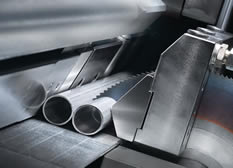Cut and bent tubes
Tube Design, Inspection and Dimensioning Guidelines
Seamless steel tubes can be supplied as the cut tubes and bent tubes. Processed are mostly precision cold drawn tubes, the hot rolled tubes can be supplied as the semi-finished product. Cut tubes are designed especially for manufactures of automotive components.
Cutting tubes to each lengths using equipment and production method
• sawing
• cutting
• cutting-off
Steel grades: According to EN 10204-2.2 or 3.1B, DIN 50049;
Dimensions: upon agreement
It is important to remember that thin wall tube behaves similarly to sheet
metal. When it is shaped the longitudinal weld seam reacts differently than the
base metal. This shows in the finished part a variety of ways but the most
obvious effect is that the ends of the tube are not exactly round. As in any
manufactured product, the tighter the tolerance the more work must be performed
to meet those tolerances. Accordingly, do not make the tolerances any tighter
than necessary or you will be incurring unnecessary expense.
Bend Radius
The tube bending industry typically measures the bend radius along the center-line of the tube. It is termed “CLR”, an acronym for Center-line Bend Radius. The smaller the bend radius the more the tube must elongate or stretch.
Different materials are more ductile than others which means some materials can be bend on smaller or “tighter” radii than others. The theoretical amount a tube must elongate for a given bend radius is determined by the following formula: (1⁄2 x Diameter of the Tube) / CLR = % elongation required. For example, the material on the outside of a bend in a 4” Diameter Tube, bent on a 4 inch CLR, would have to elongate 50%.
Typical material elongation limits:
- Steel : 42%
- Stainless Steel : 60%
- Aluminum : 30%
- Standard Pipe: 10%
- Annealed Stainless Steel : 33%
For more information contact us for tube cuts and bends.

